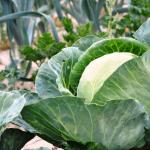Growing Cabbage
Brassica sp. : Brassicaceae / the mustard or cabbage family
| Jan | Feb | Mar | Apr | May | Jun | Jul | Aug | Sep | Oct | Nov | Dec |
|---|---|---|---|---|---|---|---|---|---|---|---|
| S | S | S | S | ||||||||
| T | T | T | T |
(Best months for growing Cabbage in New Zealand - cool/mountain regions)
- S = Plant undercover in seed trays
- T = Plant out (transplant) seedlings
- Easy to grow. Grow in seed trays, and plant out in 4 weeks. Sow seed at a depth approximately three times the diameter of the seed. Best planted at soil temperatures between 5°C and 18°C.
- Space plants: 50 - 75 cm apart
- Harvest in 11-15 weeks.
- Compatible with (can grow beside): Dwarf (bush) beans, beets, celery, cucumber, onions, marigold, nasturtium, rhubarb, aromatic herbs (sage, dill, chamomile, thyme)
- Avoid growing close to: Climbing (pole) beans, tomato, peppers (chili, capsicum), eggplant (aubergine), strawberry, mustard, parsnip
There are many varieties of cabbage.
Those which stand winter weather usually have darker leaves and a stronger flavour, e.g. Savoy.
Red cabbage is grown in a similar way to green varieties.
In temperate climates ff you plant a selection of types you can have cabbage growing all year round.
Culinary hints - cooking and eating Cabbage
Young spring cabbage can be chopped and added to salad greens.
Steaming preserves the goodness and flavour of cabbage.
Can also be used in stir-fry.
Red cabbage chopped and cooked with brown sugar, red wine, onions, vinegar and stock is served with boiled bacon or pork.



Your comments and tips